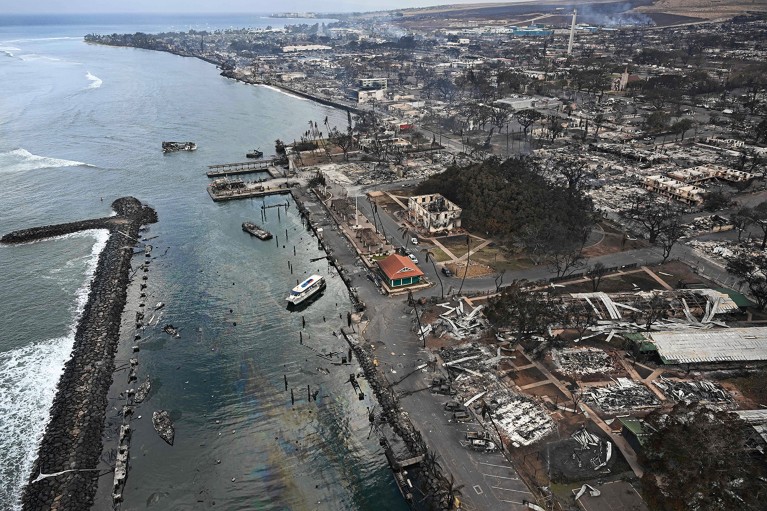Maui, Hawaii, August 14: A catastrophic wildfire is causing severe destruction on Maui, Hawaii making it one of the deadliest fires seen in the United States in a century. With a tragic count of at least 111 lives lost and thousands now homeless, the island faces an unprecedented emergency.
The blaze has scorched more than 2,100 acres (850 hectares) of settlement land, leading to enormous economic losses of around $5.5 billion. This financial blow is equivalent to roughly 7% of Hawaii’s overall economic output, casting a shadow over the state’s economic stability.
This devastating blaze underscores the mounting economic toll of wildfires worldwide.
Climate change-driven factors, including prolonged fire seasons, rising temperatures, and shifting weather patterns, are intensifying wildfires.
Alarmingly, human activities were responsible for a striking 85% of reported wildfires in 2022, underscoring the human role in exacerbating this global issue.
The years 2019-2021 bore witness to rampant wildfires globally. In 2019, Siberia, Alaska, the Canary Islands, Australia, and the Amazon rainforest were ravaged by unrelenting fires, often fueled by illegal logging. Smoke choked major cities, compromising air quality.
The following year, 2020, wildfires escalated by 13%, driven by climate change, deforestation, and agricultural burning. In 2021, record-breaking blazes plagued Turkey, Greece, California, and Russia, linking their surge to climate change.
The ramifications of wildfires extend beyond biodiversity and lives. A profound impact on economies becomes evident as they ravage communities and industries across vast expanses.
A study from University College London found that California’s 2018 wildfires cost the US a huge $148.5 billion, with $59.9 billion spent on losses and health expenses within the state.
As highlighted by a report from the US Senate Budget Committee, the ongoing economic toll of wildfires within the United States is estimated to be as high as $347.8 billion annually. Presently, a considerable 99 million people and 46 million homes, valued at approximately $1.3 trillion, remain at risk of wildfires.
On a global scale, the surge in wildfire-related insurance claims has reached a significant annual total of $10 billion.
In Canada, the expenses related to “health impacts”, separate from other damages, due to forest fires over a short period of five days (June 4-8, 2023) reached a significant $1.28 billion, and that too in just one province, Ontario.
Economists have calculated that the 2019-20 Australian bushfires, which occurred from December 2019 to January 2020, stand as Australia’s most expensive natural disaster to date. These fires resulted in property damage and economic losses amounting to an estimated $57-66 billion (equivalent to AUD $78-88 billion) in a mere span of two months.
Indonesia faced significant costs of $5.2 billion due to land and forest fires, even though the affected area was just one-third the size of Australia’s fire.
Experts predict that damage caused by forest die-back in the Amazon could range from $957 billion to a massive $3.5 trillion over the next 30 years, with forest fires being a major contributing factor. This risk surpasses the combined economic output of the countries within the Amazon basin.
During 2022, numerous European nations, including Spain, Romania, Portugal, Bosnia and Herzegovina, France, Italy, Croatia, Montenegro, Greece, and the UK, were impacted by wildfires.
Spain, in particular, faced a severe wildfire situation in August 2022, which resulted in an estimated total damage cost of around $3.5 billion (€2.975 billion).
Spain’s neighboring country, Portugal, also encountered significant wildfires. Approximately 100,098 hectares of land were affected by fires, resulting in a reported cost of $1.22 billion (€1.034 billion).
Meanwhile, France and Italy witnessed damage costs of $757 million and $618 million, respectively.
Unlike Hawaii and other wildfire damage estimations, the global assessment of wildfire damage costs remains challenging due to insufficient data, inadequate reporting practices, and the complex nature of the damages.
However, concerning extreme weather, climate, and water-related incidents, there were 11,778 documented disasters from 1970 to 2021. These events led to over 2 million deaths and economic losses amounting to US$ 4.3 trillion, as reported by the World Meteorological Organization (WMO). This financial toll is rapidly rising due to the accelerating impacts of climate change.
It’s crucial to recognize that climate change isn’t solely affecting the environment; its economic consequences are substantial and escalating with an unprecedented scale of global warming.
The United Nations Environment Programme emphasizes that our planet is heading towards a warming of 2.7°C, surpassing the 2-degree Celsius target set by the Paris Agreement. This serves as a pressing call to action, underscoring the need to address climate change with urgency.






